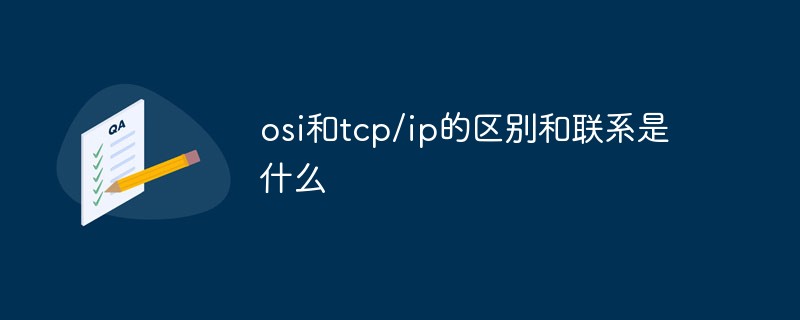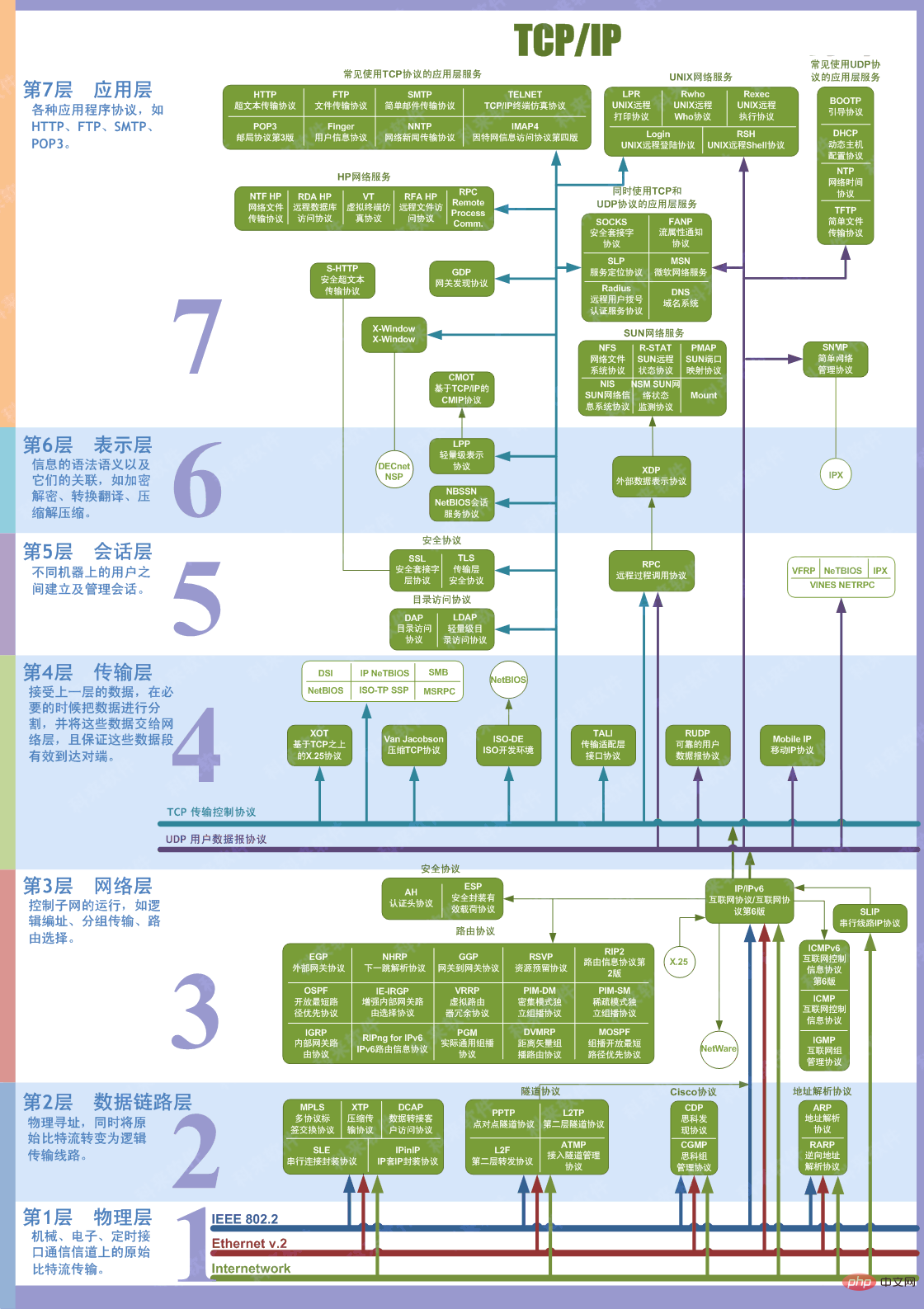What is the difference and connection between osi and tcp/ip
Difference: 1. TCP/IP is a protocol cluster, while OSI is a model; 2. TCP/IP is a five-layer structure, while OSI is a seven-layer structure; 3. The third layer of TCP/IP Only IP protocol is supported, OSI supports all network layer protocols. Connection: 1. OSI introduces the concepts of services, interfaces, protocols, and layers, while TCP/IP draws on the concepts of OSI; 2. OSI has models first, then protocols, standards first, and then practices, while TCP/IP IP first has protocols and applications and then proposes a model, which is the reference OSI model.

The operating environment of this tutorial: Windows 7 system, Dell G3 computer.
OSI definition:
OSI (Open system interconnect), that is, open system interconnection. Generally called the OSI reference model, it is a network interconnection model studied by ISO (International Organization for Standardization) in 1985. In order to make the Internet more popular, ISO launched the OSI model. The implication is that all companies are recommended to use this specification to control their networks. In this way, all companies will have the same specifications and can interconnect.
OSI defines a seven-layer framework for network interconnection (physical layer, data link layer, network layer, transport layer, session layer, presentation layer, application layer)
Each layer Function:
#Application layer: The application layer is the highest layer of the OSI reference model and is the interface between the user and the network.
Presentation layer: The presentation layer handles the representation of data encoding flowing through nodes to ensure that the information sent by the application layer of one system can be read by the application layer of another system. Data formatting, data encryption
Session layer: The main function of the session layer is to manage and coordinate the communication (dialogue) between various processes on different hosts, that is, it is responsible for establishing, managing and terminating Session establishment, management and maintenance between applications
Transport layer: The role of the transport layer is to provide end-to-end reliable and transparent data transmission services for upper layer protocols, including error handling issues such as control and flow control.
Network layer: The network layer provides services for the transport layer. The protocol data units transmitted are called packets or packets.
Data link layer: The data link layer provides services for the network layer and solves communication problems between two adjacent nodes.
Physical layer: The physical layer is the lowest layer of the OSI reference model, which uses the transmission medium to provide physical connections for the data link layer.
Each layer implements its own functions and protocols, and completes interface communication with adjacent layers. OSI service definitions detail the services provided by each layer. The service of a certain layer is a capability of that layer and the layers below it, which is provided to the higher layer through the interface. The services provided by each layer have nothing to do with how these services are implemented.
As we all know, the OSI reference model is an international academic and legal standard and a complete and authoritative network reference model. The TCP/IP reference model is the de facto international standard, that is, the network reference model that is widely used in real life.
The relationship between OSI and TCP/IP
OSI introduces the concepts of services, interfaces, protocols, and layers, and TCP/IP draws on them These concepts of OSI establish the TCP/IP model.
OSI has models first, protocols later, standards first, and practices later; TCP/IP, on the contrary, has protocols and applications first and then proposes a model, and it is a reference OSI model.
OSI is a theoretical model, while TCP/IP has been widely used and has become the de facto standard for network interconnection.
TCP:transmission control protocol Transmission Control Protocol
UDP:user data protocol User Datagram Protocol
The difference between OSI seven layers and TCP/IP:
1. TCP/IP is a protocol cluster; while OSI (Open Systems Interconnection) It is a model, and TCP/IP was developed before OSI.
2. TCP/IP is a hierarchical protocol made of some interactive modules, each of which provides specific functions; OSi specifies which function belongs to which layer.
3. The number of layers is different—TCP/IP is a five-layer structure, while OSI is a seven-layer structure. The highest three layers of OSI are represented by the application layer in TCP.
Classic diagram

4. The third part of the TCP/IP model The TCP/IP model only supports IP protocols, and OSI supports all network layer protocols
5. The TCP/IP model supports cross-layer encapsulation; the OSI model does not support it; Cross-layer encapsulation is mainly used between non-terminal devices (PC...) Traffic communicating with each other, not long distance;
When there is no transport layer, the IPV4 header will fragment the application layer traffic, and then fill the fragmentation information in the IPV4 header;
Use protocol number to mark application layer traffic, protocol number 0-255;
Protocol 6 marks the transport layer as TCP, protocol number 17 Indicates that the transport layer is UDP; all other numbers correspond to cross-layer encapsulation traffic; the ICMP protocol number is 1, OSPF is 89, and EIGRP88;
For more related knowledge, please visit the FAQ column!
The above is the detailed content of What is the difference and connection between osi and tcp/ip. For more information, please follow other related articles on the PHP Chinese website!

Hot AI Tools

Undresser.AI Undress
AI-powered app for creating realistic nude photos

AI Clothes Remover
Online AI tool for removing clothes from photos.

Undress AI Tool
Undress images for free

Clothoff.io
AI clothes remover

Video Face Swap
Swap faces in any video effortlessly with our completely free AI face swap tool!

Hot Article

Hot Tools

Notepad++7.3.1
Easy-to-use and free code editor

SublimeText3 Chinese version
Chinese version, very easy to use

Zend Studio 13.0.1
Powerful PHP integrated development environment

Dreamweaver CS6
Visual web development tools

SublimeText3 Mac version
God-level code editing software (SublimeText3)

Hot Topics
 1389
1389
 52
52
 What is the full name of tcp/ip?
Nov 29, 2022 pm 04:25 PM
What is the full name of tcp/ip?
Nov 29, 2022 pm 04:25 PM
The full name of tcp/ip is "Transmission Control Protocol/Internet Protocol", which means "Transmission Control Protocol/Internet Protocol" in Chinese. The TCP/IP protocol not only refers to the two protocols TCP and IP, but also refers to a protocol cluster composed of FTP, SMTP, TCP, UDP, IP and other protocols, just because in the TCP/IP protocol, the TCP protocol and the IP protocol The most representative, so it is called TCP/IP protocol.
 How to use PHP and TCP/IP protocol for data communication
Jul 29, 2023 pm 01:46 PM
How to use PHP and TCP/IP protocol for data communication
Jul 29, 2023 pm 01:46 PM
How to use PHP and TCP/IP protocol for data communication Introduction: In the modern Internet era, data communication is a very important aspect. Whether it is communication between a client and a server or communication between different servers, the TCP/IP protocol has always been one of the most commonly used communication protocols. This article will introduce how to use PHP language and TCP/IP protocol for data communication, and provide relevant code examples. 1. Introduction to TCP/IP protocol TCP/IP protocol is the basis of the Internet protocol cluster. It defines
 What model does the 7-layer network structure refer to?
Dec 05, 2022 am 10:51 AM
What model does the 7-layer network structure refer to?
Dec 05, 2022 am 10:51 AM
The 7-layer network structure refers to the OSI seven-layer model, which includes application layer, presentation layer, session layer, transport layer, network layer, data link layer, and physical layer. The physical layer is used to transparently transmit bit streams; the data link layer mainly encapsulates and decapsulates the MAC address of the data received from the physical layer, and transmits it error-free on the line between two adjacent nodes, in units of frames. data; the session layer manages remote access; the presentation layer handles the presentation of information exchanged between multiple communication systems; and the application layer provides various services to network users or applications.
 Which layer in the osi model completes addressing and routing?
Jul 08, 2022 pm 04:21 PM
Which layer in the osi model completes addressing and routing?
Jul 08, 2022 pm 04:21 PM
The "network layer" that completes addressing and routing in the osi model. The network layer mainly provides services for the transport layer. It can select the most appropriate path for packets through the communication subnet through routing algorithms, and can use IP addresses for addressing. The IP address is the network layer address that identifies each node. During the data transmission process, the target network address is calculated based on the target IP address and subnet mask, and then addressing is performed based on the target network address.
 What is the difference and connection between osi and tcp/ip
Aug 15, 2022 pm 01:55 PM
What is the difference and connection between osi and tcp/ip
Aug 15, 2022 pm 01:55 PM
Differences: 1. TCP/IP is a protocol cluster, while OSI is a model; 2. TCP/IP is a five-layer structure, while OSI is a seven-layer structure; 3. The third layer of TCP/IP only supports the IP protocol, and OSI Supports all network layer protocols. Connection: 1. OSI introduces the concepts of services, interfaces, protocols, and layers, while TCP/IP draws on the concepts of OSI; 2. OSI has models first, then protocols, standards first, and then practices, while TCP/IP IP first has protocols and applications and then proposes a model, which is the reference OSI model.
 What is the difference between tcp and ip
Sep 04, 2023 pm 02:19 PM
What is the difference between tcp and ip
Sep 04, 2023 pm 02:19 PM
TCP and IP are two different protocols in the Internet: 1. TCP is a transport layer protocol, while IP is a network layer protocol; 2. TCP provides functions such as segmentation, sorting, confirmation and retransmission of data packets. , and the IP protocol is responsible for providing source and destination addresses for data packets; 3. TCP is a connection-oriented protocol, while the IP protocol is connectionless; 4. TCP also provides flow control and congestion control.
 What are the protocols belonging to the application layer in the tcp ip reference model?
Jul 04, 2022 am 10:09 AM
What are the protocols belonging to the application layer in the tcp ip reference model?
Jul 04, 2022 am 10:09 AM
Application layer protocols include: 1. Telnet, which allows users on one machine to log in to a remote machine and perform work; 2. FTP, which provides a method to move files from one machine to another; 3. SMTP is a protocol that provides email transmission; 4. SNMP is a standard protocol used to manage network nodes in IP networks; 5. DNS is mainly used to "translate" familiar web addresses into An IP address that a computer can understand; 6. HTTP is a request-response protocol used to obtain the home page on the WWW.
 Common TCP/IP error analysis in Go language
May 31, 2023 pm 10:21 PM
Common TCP/IP error analysis in Go language
May 31, 2023 pm 10:21 PM
The Go language is a growing programming language that is designed to be ideal for implementing network applications with high performance, reliability, and concurrency. When using Go to write network programs related to the TCP/IP protocol, we are prone to encounter various errors, and some common TCP/IP errors will also bring certain difficulties to the debugging of the program. This article will focus on the topic of how to solve common TCP/IP errors in the Go language. 1. EOF error EOF (EndOfFile) error usually



